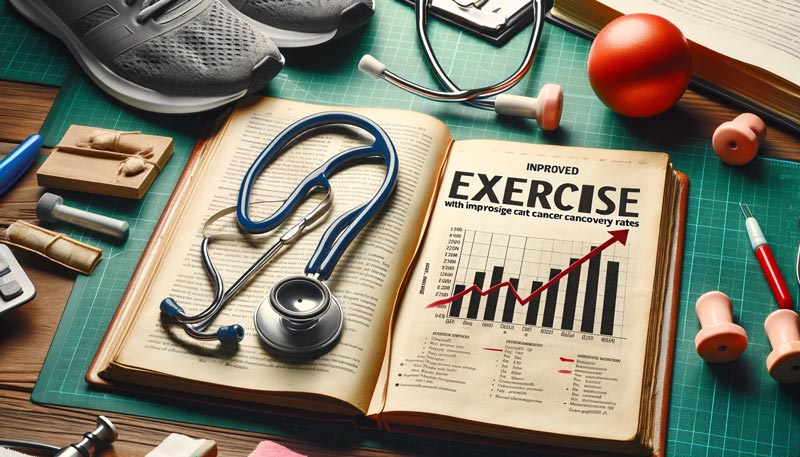By BeSund Editorial Team 11/07/2023 Modified Date: 03/05/2024
Cancer
Understand the connection between exercise and cancer
Cancer and Exercise

Understanding Cancer and Exercise
Understanding the complex relationship between cancer and exercise is vital, as cancer represents a group of over 200 distinct diseases marked by the uncontrolled proliferation of abnormal cells, which can invade other parts of the body and potentially lead to metastasis. The emergence of these cells is often due to genetic mutations or the impact of environmental carcinogens such as tobacco smoke that damage cellular DNA.
For those battling this condition, the challenges are numerous, including fatigue, muscle atrophy, and reduced cardiovascular health. However, integrating exercise into cancer care is increasingly recognised as a transformative approach to management and rehabilitation, offering substantial improvements in physical capabilities, overall well-being, and psychological health.
Personalised exercise programs are considered safe and beneficial at all stages of cancer treatment. They are endorsed by crucial health organisations for enhancing the quality of life during and after cancer.
The Global Impact of Cancer on Health and Mortality
Cancer, a leading cause of death and a crucial concern in the ‘Cancer and Exercise’ dialogue commands attention in our global health discourse. The World Health Organization’s figures from 2018 elucidate the scale—cancer is behind one in six deaths worldwide. Amongst these, lung and prostate cancers prevail in men, with women most often facing breast and colorectal cancers.
The WHO mortality database, a meticulous record of medically-certified deaths, sheds light on the pervasiveness of malignant neoplasms. These cancers, marked by unchecked growth and the potential to invade other tissues, present varied mortality trends—shaped by gender, geography, and cancer type.
The interactive visualisation above presents three distinct plots that chronicle the evolution of mortality rates. The first plot amalgamates total deaths with those from cancer, mapping health outcomes over time. The following two plots dissect this data by sex, analysing disparities and trends in gender-specific mortality. You are invited to peruse these plots and glean insights from their story.
Over seven decades, the data chronicles a remarkable shift. From the 1950s’ 7.62 million global deaths, with cancer claiming 989,878, to 2021’s 22.32 million global deaths and 4.05 million due to cancer, respectively. Despite a burgeoning global population, this upward trend underscores significant healthcare delivery and disease control challenges. It reflects an urgent need for sustained advancements in medical research and public health policies to manage and mitigate cancer’s growing impact.
The Intersection of Cancer and Exercise in Health Management
The integration of exercise into cancer management is pivotal. Exercise provides physiological benefits that can aid in the treatment and recovery of cancer patients. Research indicates that physical activity can mitigate some of the adverse effects caused by cancer and its various treatments, such as fatigue, muscle wasting, and reduced cardiovascular health.
The efficacy of exercise in managing these side effects is well-documented. It can improve physical function, quality of life, and even mental health for those undergoing cancer treatment. Tailored exercise programs are considered safe for most patients and can be beneficial throughout the treatment process.
Considering the challenges presented by cancer, it’s essential to understand how cancer and exercise connect and how exercise fits into health management strategies. Exercise programs can be adapted to individual needs and stages of treatment, ensuring that patients receive the maximum benefit with minimal risk.
Exercise as a Pillar of Cancer Care: What to Expect
With the intricate relationship between cancer and exercise established, we turn our attention to the tangible impact of this synergy. Expect to uncover how cancer affects physical performance, delving into the limitations imposed by treatments and their repercussions on the body’s capabilities.
Our forthcoming sections will explore exercise as a critical management tool, presenting evidence-based exercises that promise to enhance the quality of life for those undergoing treatment. From aerobic to flexibility routines, we’ll offer a compendium of exercises specifically beneficial for varying stages of cancer recovery.
Safety is paramount; hence, we’ll provide crucial guidelines on precautions and modifications for exercising with cancer. Assessing the complexities of living with cancer, practical fitness and lifestyle advice will be shared to empower individuals to integrate exercise safely and effectively into their daily lives.

The Impact of Cancer on Physical Performance
Cancer survivors often grapple with the long-term and late effects of treatment that can significantly limit their ability to exercise. Studies have shown a noticeable decline in physical function, with more than half of those five years post-treatment reporting limitations in everyday activities like crouching, lifting light weights, and walking short distances.
This persistent challenge underlines the importance of tailored exercise programmes that accommodate the varied capabilities of cancer survivors, aiming to improve exercise capacity in cancer survivors.
These physical performance issues are not confined to any single country or region; they are a global concern. Therefore, while discussing the intersection of cancer and exercise, it’s vital to adopt a worldwide perspective.
The most common cancer sites—breast, lung, prostate, and colorectal—are prevalent globally. Factors such as lifestyle, environment, and genetics play a crucial role in disease progression and the adaptation of exercise recommendations. To further explore the relationship between cancer and exercise, the following sections will address various dimensions of the impact of cancer on physical performance:
1. Cancer Prevalence and Exercise: A Global Outlook
Cancer prevalence and exercise frame a worldwide issue. As we consider the global impact of cancer, it’s essential to acknowledge the 13.7 million cases and their diverse origins. Lifestyle choices, environmental factors, and genetics contribute to the disease’s progression, underlining the need to develop exercise guidelines that can be applied universally, transcending geographical boundaries.
2. FITT Principle for Cancer Survivors
A single exercise recommendation for cancer survivors is not feasible due to the vast array of cancer types and treatment responses. The FITT principle—focusing on Frequency, Intensity, Time, and Type of exercise—needs to be individualised.
The American College of Sports Medicine suggests 30–60 minutes of moderate-to-vigorous physical activity on most days, aligning with these individual needs and enhancing exercise capacity in cancer survivors.
3. Bone Metastases Considerations
For those with bone metastases, exercise plans require careful modification to prevent injury due to increased bone fragility. These adjustments are crucial to maintaining as much physical activity as possible without risking fractures.
4. Cancer-Related Fatigue
Fatigue is a common issue for up to 90% of cancer survivors, often hindering their capacity to exercise. Despite this challenge, avoiding inactivity is paramount, as aerobic exercise has been shown to alleviate symptoms of fatigue.
5. Cachexia and Exercise
Muscle wasting, particularly in advanced gastrointestinal cancers, can severely limit exercise capacity. The extent of this cachexia dictates the necessary modifications to the exercise program.
6. Exercise Testing and Prescription
While standard exercise testing is generally suitable for cancer patients post-clearance, demanding comprehensive fitness assessments can deter the initiation of beneficial light exercise programs.
7. Aerobic and Resistance Exercise Adaptations
The daily variability in a cancer survivor’s capabilities, especially during active treatment, calls for a flexible approach to exercise prescriptions. This adaptability ensures that survivors can continue to engage in physical activity as consistently as possible.
8. Lymphedema Risks
Survivors who have had lymph nodes removed are at risk for lymphedema. Any signs of swelling necessitate an immediate halt to exercise and consultation with a lymphedema specialist.
9. Revaluation During Treatment Changes
Changes in treatment or disease status should prompt a reassessment of the exercise plan, adhering to the latest guidelines and ensuring the survivor’s safety and well-being.
10. Exercise Contraindications
Certain conditions, such as indwelling catheters, immune suppression, or recent radiation, preclude activities like swimming. Additionally, those undergoing chemotherapy may require periodic exercise modifications in response to fluctuations in symptoms.
The interplay between cancer and exercise is complex, yet understanding and addressing this relationship is critical for enhancing the health and quality of life of cancer survivors.

Exercise as a Management Tool for Cancer and Exercise
Physical activity stands as a strategic defence in battling cancer, especially noted in postmenopausal breast cancer, where activity is linked with decreased risk and favourable outcomes. Evidence from meta-analyses suggests that exercise post-diagnosis can significantly lower the risk of breast cancer mortality, reinforcing the pivotal role of exercise in cancer care.
This protective effect is mirrored in colon cancer, where physical activity is associated with risk reduction. Furthermore, studies indicate an 11% decrease in pancreatic cancer risk for physically active individuals, accentuating the broad potential of exercise in cancer prevention.
For cancer survivors, exercise is not just beneficial; it’s transformative. It alleviates cancer-related fatigue and enhances quality of life, endorsing it as a fundamental element of post-treatment recovery.
Specific exercise prescriptions, such as low-intensity aerobic activities, strength training, and balance exercises like yoga, have distinct benefits, from improving fatigue to bolstering bone health.
Yoga, in particular, offers cancer survivors improved sleep and a tranquil respite, provided types like Yin and Hatha are chosen over more intense varieties. The overall message is clear: incorporating cancer and exercise into survivorship plans can yield significant physical and psychosocial improvements, paving the way for a more robust recovery.
Recommended Exercises for Individuals with Cancer
Cancer and exercise are intricately linked, with a growing body of evidence supporting the role of physical activity in aiding recovery and improving the quality of life for those affected by cancer.
Anaerobic activities, including resistance training with light weights or resistance bands, are equally beneficial, targeting muscle strength and combating the muscle wasting often associated with cancer treatments.
These exercises can be adapted to each individual, allowing cancer patients to engage in physical activity safely during and after treatment. The emphasis is on moderate intensity and gradual progression, tailored to individual tolerance and medical guidance.

Beneficial ‘Cancer and Exercise’ Recovery Programs
Transitioning to the specific exercises, we understand that the journey with cancer is unique for each individual. The following list provides a structured approach to incorporating exercise into the cancer and exercise treatment and recovery process.
1. Aerobic:
- Walking: Start with short distances and increase as tolerated.
- Cycling: Use a stationary bike for safety and convenience.
- Swimming: Low impact and supportive of joints and muscles.
2. Resistance:
- Free Weights: Begin with light weights, focusing on form.
- Resistance Bands: Versatile and adaptable to strength levels.
- Body Weight Exercises: Includes activities like sit-to-stands.
3. Flexibility:
- Stretching: Target all major muscle groups, holding each stretch for 10–30 seconds.
- Range of Motion Exercises: Move each joint through its entire movement capacity.
4. Balance and Coordination:
- Tandem Stands: Progress from semi-tandem to single-leg as balance improves.
- Coordination Drills: Assist in managing neuropathy and cognitive changes.
FITT Recommendations for Cancer Survivors
The FITT principle provides a framework for creating exercise prescriptions that are evidence-based and personalised for cancer survivors. It stands for Frequency, Intensity, Time, and Type of Exercise, allowing for adaptability based on individual capacities and treatment responses. Here are the general FITT recommendations for cancer survivors:
- Frequency: Engage in aerobic and resistance exercises 3–5 days per week.
- Intensity: Aim for moderate to vigorous levels, tailored to personal capabilities and using RPE (Rating of Perceived Exertion) to monitor exertion.
- Time: Accumulate 75 minutes of vigorous or 150 minutes of moderate aerobic activity weekly, with resistance training 2–3 days per week.
- Type: Include a combination of aerobic, resistance, and flexibility exercises, emphasising large muscle groups and activities that promote functional fitness.
Each exercise session should be preceded by a warm-up and followed by a cool-down to prevent injury and manage fatigue. Safety is paramount, and any exercise program should be developed in consultation with healthcare providers to ensure it aligns with the survivor’s health status and treatment plan.

Safety Measures and Precautions for Cancer and Exercise
Embarking on an exercise program after a cancer diagnosis requires careful consideration of safety measures and precautions. The meeting of cancer and exercise presents unique health challenges, making the safety of engaging in physical activity a critical concern.
Clear medical guidance is vital to tailor exercise to individual capabilities and limitations, ensuring the safety and efficacy of physical activity at various stages of treatment and recovery.
Implementing safety measures and precautions in the context of cancer and exercise encompasses various strategies, from medical clearances to tailored exercise modifications.
These strategies are grounded in a deep understanding of how the interplay between cancer and exercise impacts an individual’s body and are designed to promote healing and quality of life during and after treatment.
With these considerations in mind, we present specific measures necessary to safeguard patients as they incorporate exercise into their cancer journey.
Medical Clearances Before Exercise
Before starting any exercise program, individuals with cancer must obtain medical clearance. This precaution is especially critical given the diverse effects of cancer and exercise on the body. The American College of Sports Medicine underscores the need for a thorough preparation of health screening tailored to the patient’s history and health status.
Exercise Modifications Based on Cancer Treatment
The impact of cancer treatments on exercise cannot be overstated. For instance, chemotherapy drugs can cause systemic side effects like neuropathy, affecting balance and coordination. This necessitates modifications to exercise plans to accommodate such limitations and possibly using perceived exertion levels instead of heart rate for intensity monitoring.
Monitoring During Exercise
During exercise, cancer patients should be attentively monitored for any abnormal symptoms, such as unusual pain or fatigue. Any significant changes might indicate the need to adjust the exercise program. Patients with a history of radiation may have localised damage, requiring a modified exercise regime to avoid exacerbating the condition.
Progression and Adaptation
Exercise progression for cancer survivors often requires a slower pace. Adjustments to the frequency, intensity, and type of exercise are vital based on the individual’s response to activity. It is crucial to ensure that exercise does not worsen symptoms such as lymphedema or pain.
Special Considerations
Certain conditions, like recent surgery or an ostomy bag, demand specific precautions. These include avoiding public pools to reduce infection risks and using specialised equipment to monitor any increase in symptoms.
Living with Cancer: Exercise and Lifestyle Tips
Physical activity is essential for cancer survivors, offering substantial benefits at all stages—from diagnosis to ongoing recovery. Contrary to old-school advice that promoted rest, current guidelines advocate for cancer patients to maintain an active lifestyle, helping to improve not only their physical capabilities but also their overall well-being.
Cancer and exercise should go hand-in-hand, with bespoke exercise programmes tailored to individual capacities and daily fluctuations in energy levels. Special considerations include managing fatigue, cognitive changes, and potential lymphedema with carefully modified exercises.
The exercise program should be adaptable, recognising the variability in a patient’s ability to engage in aerobic, resistance, and flexibility training.
For those with balance concerns or weakened bones, safety is paramount. Options like stationary cycling, recumbent stepping, or water aerobics can provide safer alternatives to treadmill use. Resistance training can begin on machines to ensure stability and control, and flexibility exercises may be adapted for seated positions to minimise fall risk.
Cancer and exercise programmes must also consider pre-existing health conditions and the specific location and stage of cancer. A well-rounded program, guided by FITT-VP principles—frequency, intensity, time, type, volume, and progression—is integral to crafting a safe and effective exercise plan.
Close monitoring during exercise for any new or worsening symptoms is crucial, with appropriate modifications or pauses in the program as required. For those experiencing or at risk of cardiotoxicity, tailored exercise prescriptions are vital, taking into consideration any medications that may affect heart rate during physical activity.
Maintaining physical activity during adjuvant treatments like chemotherapy and radiation is recommended. However, the intensity may vary in response to treatment cycles. Post-treatment exercise plays a crucial role in managing the side effects of ongoing therapies and improving survival prospects.
Finally, each cancer survivor’s journey is unique, requiring a personalised approach to exercise and lifestyle adjustments. Progression should be gradual and responsive to individual tolerances, focusing on maintaining or enhancing physical function. Regular physical activity is a cornerstone of a cancer survivor’s lifestyle, crucial for managing the disease and improving quality of life.
Sources
- American College of Sports Medicine. ACSM’s Guidelines for Exercise Testing and Prescription. 10th ed. Philadelphia (PA): Wolters Kluwer; 2018.
- Arem, H., Moore, S. C., Park, Y., et al. Physical activity and cancer-specific mortality in the NIHAARP Diet and Health Study cohort. International Journal of Cancer. 2014;135(2):423–31.
- Brown JC, Huedo-Medina TB, Pescatello LS, et al. Efficacy of exercise interventions in modulating cancer-related fatigue among adult cancer survivors: a meta-analysis. Cancer Epidemiol Biomarkers Prev. 2011;20(1):123–133.
- Cheema BS, Kilbreath SL, Fahey PP, Delaney G, Atlantis E. Safety and Efficacy of Progressive Resistance Training in Breast Cancer: A Systematic Review and Meta-Analysis. Breast Cancer Res Treat. 2014;148:249–68.
- Courneya, Kerry & Vardy, Janette & Gill, Sharlene & Jonker, Derek & O’Brien, Patti & Friedenreich, Christine & Dhillon, Haryana & Wong, Rebecca & Meyer, Ralph & Crawford, Jennifer & Campbell, Kristin & Prapavessis, Harry & O’Callaghan, Christopher & Turner, Jane & Spencer, Lissa & van der Ploeg, Hidde & Tu, Dongsheng & Booth, Christopher. (2014). Update on the Colon Health and Life-Long Exercise Change Trial: A Phase III Study of the Impact of an Exercise Program on Disease-Free Survival in Colon Cancer Survivors. Current Colorectal Cancer Reports.
- Demark-Wahnefried W, Platz EA, Ligibel JA, et al. The role of obesity in cancer survival and recurrence. Cancer Epidemiol Biomarkers Prev. 2012;21(8):1244-1259.
- Denlinger CS, Ligibel JA, Are M, Baker KS, Demark-Wahnefried W, Dizon D, Friedman DL, Goldman M, Jones L, King A, Ku GH, Kvale E, Langbaum TS, Leonardi-Warren K, McCabe MS, Melisko M, Montoya JG, Mooney K, Morgan MA, Moslehi JJ, O’Connor T, Overholser L, Paskett ED, Peppercorn J, Raza M, Rodriguez MA, Syrjala KL, Urba SG, Wakabayashi MT, Zee P, McMillian NR, Freedman-Cass DA; National comprehensive cancer network. Survivorship: healthy lifestyles, version 2.2014. J Natl Compr Canc Netw. 2014 Sep;12(9):1222-37.
- Farris MS, Mosli MH, McFadden AA, Friedenreich CM, Brenner DR. The association between leisure time physical activity and pancreatic cancer risk in adults: a systematic review and meta-analysis. Cancer Epidemiol Biomarkers Prev. 2015;24(10):1462–73.
- Garcia, D. O., Thomson, C. A. Physical activity and cancer survivorship. Nutrition in Clinical Practice. 2014;29(6):768–79.
- Gonçalves AK, Dantas Florêncio GL, de Atayde Silva MJ, Cobucci RN, Giraldo PC, Cote NM. Effects of physical activity on breast cancer prevention: a systematic review. J Phys Act Health. 2014;11(2):445–54.
- Hamo CE, Bloom MW, Cardinale D, Ky B, Nohria A, Baer L, Skopicki H, Lenihan DJ, Gheorghiade M, Lyon AR, Butler J. Cancer Therapy-Related Cardiac Dysfunction and Heart Failure: Part 2: Prevention, Treatment, Guidelines, and Future Directions. Circ Heart Fail. 2016 Feb;9(2):e002843.
- Hewitt M, Greenfield S, Stovall E. From Cancer Patient to Cancer Survivor: Lost in Transition. Washington, DC: National Academies Press; 2006.
- Lahart IM, Metsios GS, Nevill AM, Carmichael AR. Physical activity, risk of death and recurrence in breast cancer survivors: a systematic review and meta-analysis of epidemiological studies. Acta Oncol. 2015;54(5):635–54.
- McNeely ML, Courneya KS. Exercise programs for cancer-related fatigue: evidence and clinical guidelines. J Natl Compr Canc Netw. 2010;8(8):945–53.
- Mustian KM, Sprod LK, Janelsins M, et al. Multicenter, randomized controlled trial of yoga for sleep quality among cancer survivors. J Clin Oncol. 2013;31(26):3233-3241.
- National Center for Health Statistics (US). Health, United States, 2015: With Special Feature on Racial and Ethnic Health Disparities. Hyattsville (MD): National Center for Health Statistics (US); 2016 May. Report No.: 2016-1232.
- National Cancer Institute. Side Effects of Cancer Treatment. National Cancer Institute. [cited 07 November 2023].
- National Cancer Institute. What is cancer? National Cancer Institute. [cited 07 November 2023].
- National Lymphedema Network Medical Advisory Committee. Position Statement of the National Lymphedema Network. [cited 07 November 2023]
- Ness KK, Wall MM, Oakes JM, Robison LL, Gurney JG. Physical performance limitations and participation restrictions among cancer survivors: a population-based study. Ann Epidemiol. 2006;16(3):197–205.
- Parent M-É, Rousseau M-C, El-Zein M, Latreille B, Désy M, Siemiatycki J. Occupational and recreational physical activity during adult life and the risk of cancer among men. Cancer Epidemiol. 2011;35(2):151–9.
- Rock CL, Doyle C, Demark-Wahnefried W, et al. Nutrition and physical activity guidelines for cancer survivors. CA Cancer J Clin. 2012;62(4):243-74.
- Schmitz KH, Ahmed RL, Troxel A, et al. Weight Lifting for Women at Risk for Breast Cancer–Related Lymphedema: A Randomized Trial. JAMA. 2010;304(24):2699-2705.
- Schmitz K, Ahmed RL, Troxel A, Cheville A, Smith R, Grant LL, Bryan CJ, Williams-Smith CT, Greene QP. Weight lifting in women with breast cancer-related lymphedema. N Engl J Med. 2009;361:664-673.
- Schmitz KH, Courneya KS, Matthews C, et al. American College of Sports Medicine roundtable on exercise guidelines for cancer survivors. Med Sci Sports Exerc. 2010;42(7):1409–26.
- Schneider, C. M., Dennehy, C. A., Roozeboom, M., Carter, S. D. A model program: exercise intervention for cancer rehabilitation. Integrative Cancer Therapies. 2002;1(1):76–82.
- World Health Organization. Cancer. Geneva (Switzerland): World Health Organization. [cited 07 November 2023]



